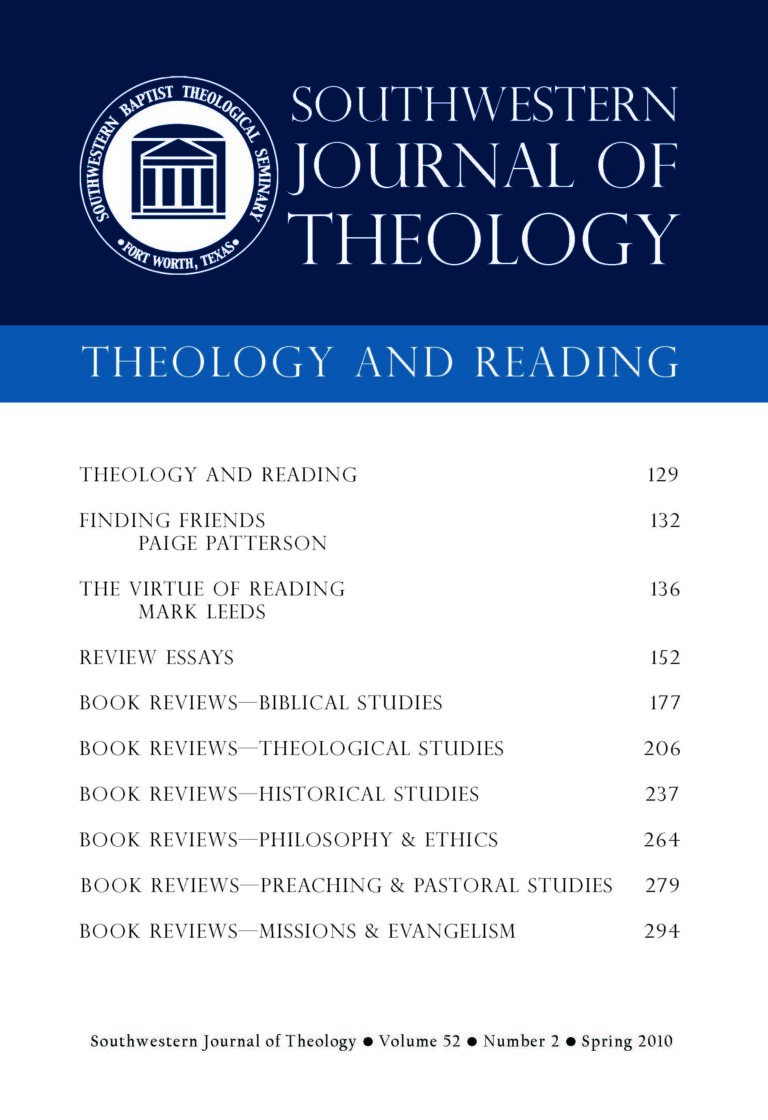
Theology and Reading
Southwestern Journal of Theology
Volume 52, No. 2 – Spring 2010
Managing Editor: Malcolm B. Yarnell III
By Paul Barnett. After Jesus, vol. 2. Grand Rapids: Eerdmans, 2008. 240 + xvi pages. Softcover, $14.26.
Books on Paul abound these days. Sadly, some scholars paint a pessimistic portrait of this man that they claim hijacked and recast Christianity (11–14). Because many of them reject the historicity of Acts as well as Pauline authorship of over half of his thirteen NT epistles, they concoct a skewed picture of Paul.
Refreshingly, Paul Barnett, lecturer at Moore Theological College, Sydney, as well as teaching fellow at Regent College, gives an accurate and thought-provoking picture of Paul in Paul: Missionary of Jesus, the second volume in his After Jesus trilogy. Trusting the historicity and veracity of Acts as well as all thirteen of Paul’s NT epistles (3, 208–10), Barnett examines Paul’s life, delves some into his theology, and reveals helpful insights into this major missionary and colorful convert to Christianity.
At the heart of the book is the answer to the question at the forefront of Pauline studies: Did Paul accurately represent or falsely distort Jesus and his teachings (2, 99)? Was Paul’s mission to Gentiles acceptable or aberrant? After a careful comparison of Paul’s writings along with the canonical Gospels, Barnett shows that Paul followed Jesus’ Israel-to-nations approach of gospel proclamation (111, 116).
Barnett practices careful scholarship, using ancient sources as well as the most recent Pauline studies, and he shows a positive respect for the biblical text. He deftly deals with opponents’ views in a scholarly and respectful way (e.g., Terrence Donaldson’s theory of a pre-conversion Pauline disposition to Jewish proselytism, 123–26; E.P. Sander’s theory of covenantal nomism, 130–32). Barnett is honest about questions concerning Paul that must remain unanswered (2).
Several helpful contributions of this book include addressing and giving insight into areas most scholars or students tend to ignore: (1) focusing on the impact of Paul’s formative years spent in Jerusalem, A.D. 17–34 (30), thus showing the theological closeness of the background of both Jesus and Paul (Palestinian rather than Hellenistic Judaism) (16–17), (2) postulating why Paul abandoned or rejected Gamaliel’s laissez-faire attitude toward the church (49, 51–53), (3) noting the chronological closeness of Paul’s conversion to Jesus’ resurrection (15–16), (4) comparing Paul’s Levantine years with the more well-known Gentile mission years (76–98), and (5) explaining several reasons why Paul took the Gospel to the Gentiles (137–40). Even Barnett’s most speculative ideas are intriguing: (1) that Saul took or was given the name “Paul” from Sergius Paulos on Cyprus and then went to the proconsul’s relatives who lived in Pisidian Antioch (206), and (2) the minority view that the location of Paul’s imprisonment, from which he wrote the Prison Epistles, was Ephesus rather than the traditional site of Rome or even Caesarea Maritima (215–17).
The book has few shortcomings. With the body of the book running just over two hundred pages, one wishes for more information at times, such as in the answer to covenantal nomism and the New Perspective on Paul (130–32) and the closing chapter which covered Paul’s achievements (198–204). “Jews becoming proselytes” should be “Gentiles becoming proselytes” (38n43).
This excellent volume will benefit both student and scholar. Barnett gives an accurate picture of Paul based on the biblical texts and presents plausible speculation on Paul based on historical background information.





